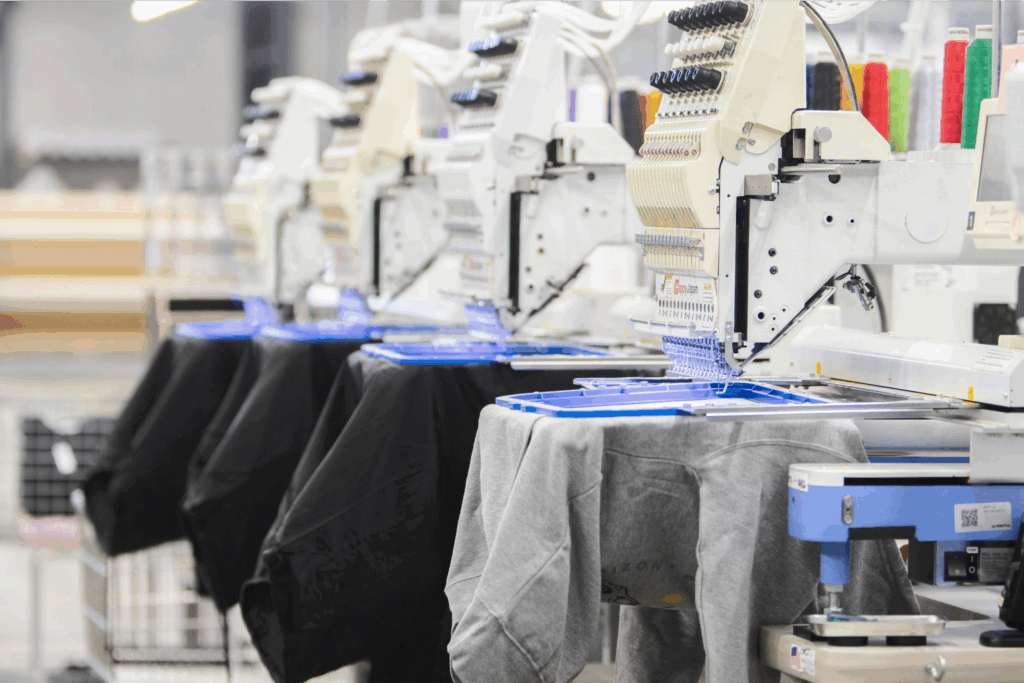Sell custom products without inventory
So, you’re starting your online store and have heard about dropshipping. Now, you want to know more about dropshipping vs eCommerce and which model is better for you.
Let’s start by stating that there is no actual competition, as dropshipping is an eCommerce fulfillment method.
We’ll check the advantages and operational dynamics of dropshipping as an eCommerce business model. We’ll also provide a precise understanding for aspiring and established entrepreneurs alike.
The difference between eCommerce and dropshipping

Dropshipping and other eCommerce models can differ in how products are sourced, stored, and shipped to customers. While both models operate within the online business realm, they cater to different preferences and capabilities of entrepreneurs.
eCommerce represents the broader category of selling goods and services online using many different methods – including dropshipping.
Some business owners want complete control over their stock, directly manage customer relations, and ensure product quality by themselves.
In that case, the model may involve a hefty initial investment and ongoing costs as the owners must manage inventory, fulfillment, and customer support.
For instance, sellers may start storing goods in a garage, but as the business grows, they’ll need to rent space in warehouses or fulfillment centers.
The dropshipping business model offers a more streamlined approach to selling online since the retailer does not keep goods in stock. Instead, they transfer customer orders and shipment details to either the manufacturer or a wholesaler, who then ships the goods directly to the customer.
This significantly reduces the risk and initial investment, making it an attractive option for entrepreneurs starting their online store with limited capital.
Some partners may also handle customer support, either completely or partially.
eCommerce vs dropshipping: key differences
- Initial investment. Starting an eCommerce business may require a large inventory and fulfillment center investment. However, entrepreneurs can launch a dropshipping business with minimal upfront costs.
- Inventory management. eCommerce businesses handle their inventory and have more control over their supply chain, while dropshipping companies rely on third-party suppliers for inventory management.
- Profit. Traditional eCommerce enterprises often enjoy higher profit margins due to direct sourcing and bulk purchasing. Dropshipping businesses might face lower profit margins due to the intermediary role of a fulfillment company or supplier.
- Control over fulfillment and branding. eCommerce business owners completely control their branded products and customer experience. Dropshipping stores have less control over product assortment and minimal control over the shipping costs and supplier’s branding.
The eCommerce business model

Running an eCommerce store involves more than just selling products online. It includes the entire process of creating your own website, managing inventory, fulfilling customer orders, and providing post-purchase support.
This business model suits entrepreneurs who wish to build a brand around their own products and have direct interaction with their customer base.
Benefits of running a regular eCommerce business
- Higher profit margins. eCommerce businesses can potentially secure better profits by sourcing products in bulk and managing the fulfillment process.
- Product and brand development. Owners have more control over product development, allowing them to build and promote their own brand better.
- Quality control. Access to inventory allows for hands-on quality checks to ensure customers receive the best products.
- Customer relations. Direct interaction with customers through the order fulfillment process allows you to personalize customer service and manage customer relations effectively.
What’s the catch?
Regular eCommerce business models require dealing with unsold stock, higher initial spending with inventory and fulfillment, and the complexities of managing the supply chain.
The dropshipping business model

How does dropshipping work? The dropshipping business method stands out for its accessibility and flexibility. It allows entrepreneurs to sell items on an eCommerce website without the need to handle physical products.
This model particularly appeals to new small business owners, as it minimizes the risk associated with unsold products and upfront costs.
Benefits of running a dropshipping business
- Low initial investment. The most compelling advantage is the low barrier to entry, allowing entrepreneurs to launch their dropshipping store with minimal expenditure.
- Flexibility. With no inventory to manage, any business owner can experiment with a wide range of products to find what sells best.
- Scalability. As the business grows, scaling up doesn’t require a significant increase in operational complexity or investment.
- Reduced risk. The dropshipping model mitigates the risk of unsold inventory, as the eCommerce store orders products only after a customer purchases them.
What’s the catch?
Dropshipping businesses may face challenges, like lower profit margins due to reliance on dropshipping suppliers, limited control over order fulfillment, and potential issues with quality control.
Make it happen today!
Dropshipping and eCommerce fulfillment comparison
A critical aspect of both dropshipping and traditional eCommerce is the fulfillment process, which includes everything from storing inventory to packing and shipping products to customers.
Let’s compare how each model handles it:
| Dropshipping model | eCommerce model | |
|---|---|---|
| Initial investment | Low | Higher |
| Profit margins | Lower | Higher |
| Inventory management | Supplier’s responsibility | Business’s responsibility |
| Order fulfillment | Handled by suppliers | Managed by the business or third-party logistics |
| Quality control | Limited | Direct |
| Branding possibilities | Limited | Extensive |
| Risk | Lower | Higher |
How to start an eCommerce business with Print on Demand dropshipping

Why not choose the best of both worlds – make money online and sell custom products with high-quality control, low risk, and no inventory management?
Print on Demand (POD) is a hybrid model that combines the low-risk aspect of dropshipping with the personalization of other eCommerce alternatives.
This approach is particularly suited for entrepreneurs looking to sell custom-designed merchandise without the hassle of inventory management.
– Customization. Create and sell unique products with your own brand.
– Low risk. Like dropshipping, there’s no need to hold inventory.
– Brand building. Allows for creative expression and brand development through custom designs.
– Sustainability. Products are only produced after a customer places an order, so no unsold stock goes to waste.
Printify can easily integrate with your online store, streamlining the process from product creation to fulfillment.
Starting an online store with POD dropshipping is simple – just follow these steps.
Create a Printify account
- Go to Printify and register for a free account.
Select and design your merchandise
- Browse our Catalog and pick items that fit your brand’s niche.
- Use our Product Creator (formerly known as the Mockup Generator) to upload your artwork or designs onto your chosen products.
- Pay attention to the design guidelines for each product to ensure optimal print quality.
- Preview your designs on the products to confirm their appearance and adjust as necessary.
Connect your online store
- Link Printify with your platform – Printify integrates with Etsy, eBay, Shopify, Wix, Squarespace, WooCommerce, BigCommerce, and PrestaShop. You can also use the Printify API or create a Printify Pop-Up Store or a TikTok Shop.
- Follow the on-screen instructions to sync your Printify account with your online store. The integration automatically sends new orders for fulfillment.
Publish, market, and sell products
Once your products are ready, make them live in your store:
- Kickstart your marketing campaign by leveraging social media platforms like Instagram and Facebook to showcase your products.
- Implement best search engine optimization practices on your website to improve search visibility.
- Consider setting up targeted ads on Google and social media to drive initial traffic to your store.
- Engage with your audience through compelling content highlighting your products’ uniqueness and quality.
Why start selling online with Printify?
Printify simplifies fulfillment for both small and large business owners with:
- Over 900 high-quality products. A vast selection ranging from t-shirts and hoodies to accessories and home decor, ready for customization.
- Network of trusted Print Providers. We’ll take care of the fulfillment process, from printing and shipping, using our fully-vetted worldwide partners.
- No upfront costs. Start without inventory or large initial spending.
- Design your own products. Enjoy having full creative control using our beginner-friendly tools.
- Multiple integrations. Seamlessly connect with popular eCommerce platforms.
- Printify quality promise. Benefit from our ongoing quality control, ensuring our Print Partners deliver the highest print and product standards.
eCommerce vs dropshipping businesses: FAQ
Dropshipping suits those seeking low upfront investment and risk, offering ease of entry and flexibility with less control over logistics and lower profit margins.
Regular eCommerce is better for entrepreneurs aiming for higher profits and more brand control. It’s ideal if you’re willing to invest more in inventory and handle logistics – despite the higher initial cost and risk of unsold inventory.
To start a dropshipping store:
- Select a niche.
- Find reliable suppliers and partners like Printify to access a wide range of products and handle logistics.
- Use an eCommerce platform like Shopify or WooCommerce to create your online store and customize its design.
- Design custom products with detailed descriptions and images from Printify.
- Set up payment processing and define your shipping options and store policies.
- Employ digital marketing strategies like SEO, social media, and email marketing to drive traffic.
- Regularly analyze customer feedback and sales data to refine your offerings.
This depends on your business model, product type, and scale. For dropshipping and POD businesses, using a third-party supplier like Printify for fulfillment minimizes inventory and operational risks.
Traditional eCommerce businesses might benefit from self-fulfillment or partnering with a third-party logistics provider to manage inventory and shipping. This option provides a more hands-on approach.
Analyzing cost, scalability, and how much control you want will determine your best method.
POD dropshipping is a business model where products are printed and shipped to customers only after a sale, eliminating the need for inventory.
For example, you can sell custom-designed merchandise like t-shirts, mugs, and notebooks without investing in stock.
Suppliers like Printify handle the printing, packaging, and shipping directly to customers, allowing businesses to offer a wide range of personalized products with minimal risk and overhead.
Dropshipping and eCommerce business models: wrapping up
Choosing between dropshipping and regular eCommerce business methods depends on your budget and business goals. Consider how much control you want over order fulfillment and customer support.
Both models offer pathways to success in the online retail world, each with its own set of advantages and challenges:
- Regular eCommerce business methods are suitable if you provide a high up-front investment. It’s also ideal if you want more control over the business, from inventory management to customer service.
- Dropshipping is ideal for entrepreneurs looking to enter the online business world with minimal risk and investment. It offers flexibility and ease of operation, though it comes with challenges like lower profit and less control over the customer experience.
Both models have proven successful for countless online businesses, and with the right strategy, either can lead to a prosperous online store. Remember to count on Printify as your trusted dropshipping and POD partner.












